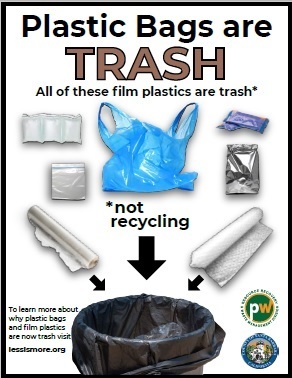
Should plastic bags, wrap, and film be placed into your curbside recycling bin, or should they be collected and taken to a designated recycling drop-off spot often located within grocery stores, hardware stores, and independent retailers?
RECYCLE PLASTIC BAGS HOW TO
Knowing how to approach plastic bag recycling is confusing for many of us. 5 Stores That Kicked Plastic Bags to the Curb: A list of major U.S.If there’s one item that business owners and individuals alike struggle to know how to recycle, it’s plastic bags.Most of the states and communities that pass plastic bag laws are located along a major waterway, and taxes are often used to fund water cleanups. The most common are either bag bans or bag taxes, while some have mandated that retailers who distribute bags must accept them for recycling. No, but there are a number of state and local community laws related to plastic bags. Are there any states that require plastic bag recycling? This is because the plastic is dyed and produces dark pellets, which limits the reprocessing options. Does bag color matter for recycling?īelieve it or not, black plastic bags are harder to recycle and sometimes omitted from store collection bins. They take more resources to produce than paper or plastic, but they should each last five to 10 years. If you’re looking for the most eco-friendly alternative, bring your own reusable bags to the store. Paper bags are also an insignificant source of marine debris, and they biodegrade, unlike plastic.

When it comes to disposal, both products are very easy to recycle, but paper bags are accepted in far more curbside programs. Paper bags are also nine times heavier, meaning they use more energy to transport. When it comes to production, paper bags require 2.2 times more energy and 4.7 times more water to manufacture than plastic bags. Which is better for the environment: paper or plastic bags?
RECYCLE PLASTIC BAGS ZIP
Use the Recycling Search to find a location near you - just enter your ZIP code. The bins are usually located near the front entrance. How do I find a bag collection bin?Īll the national grocery retailers (such as Kroger, Safeway, Target and Walmart) and many smaller retailers offer bag recycling collections in their stores. Unfortunately, bags are usually a nightmare for the machinery at recycling centers. what is the #1 source of contamination in a city’s curbside program, the answer is almost always “plastic bags.” People see the recycling symbol on the product and assume it can be included with other plastics. If you ask a recycling official in the U.S. While there are a handful of curbside programs on both coasts that accept plastic bags curbside to keep them out of the oceans, you’ll definitely want to check with your local program before recycling plastic bags at the curb. While pellets can then be reprocessed into new bags, they will most likely be shipped to a company like Trex to be manufactured into plastic lumber.įind Recycling Guides for Other Materialsįrequent Plastic Bag Recycling Questions Can I recycle plastic bags in my curbside recycling program?

Plastic bag recycling involves chipping the bags into pellets.

Recycling a ton of plastic bags (about 450,000 bags) saves 11 barrels of oil.Plastic bags don’t biodegrade, meaning it will take hundreds of years for them to decompose in a landfill.Plastic bags are among the most common sources of marine debris, where they can be mistaken as food by birds and fish.If not, you can’t be sure what plastic resin the bag is made from, so you’ll want to reuse it instead, before eventually throwing it away. Make sure any bags you are recycling have a #2 or #4 plastic symbol on them.Since they compact easily, you should be able to fit 50 to 100 plastic bags in one garbage bag. Keep a bag collection bin in your house, such as one big garbage bag for all bags.All these items will contaminate your bag load. Remove anything inside the bags, such as receipts, stickers, or crumbs.

The recycling collection system is widely available, mostly through collection bins at grocery stores. Most plastic bags are made from high-density polyethylene (#2 plastic), but the thinner-material bags (such as produce bags) are made from low-density polyethylene (#4 plastic).


 0 kommentar(er)
0 kommentar(er)
